“Reverse Engineering” of the “Terrible” apparatus from Jules Verne’s novel “The Lord of the World”
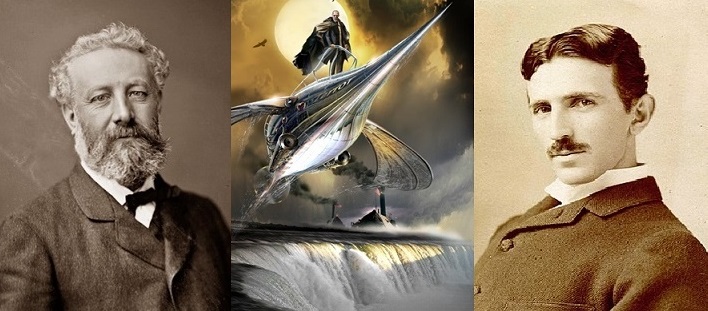
According to UNESCO statistics, Jules Verne's books occupy second place in translatability in the world, second only to the works of Agatha Christie.There are books that leave a feeling of understatement. "Lord of the World" is just one of them. So reviews and reviews of the book may have a different opinion, but a weak description of what is happening and the technical features of the apparatus of the 3 elements here stands out the most.
HE Zhukovsky, the founder of modern aeromechanics, kept in his library among the works of his predecessors the only fiction book - “Robur the Conqueror” by Jules Verne (“Lord of the World” is a continuation of “Robur the Conqueror”).
The book is based on the story of detective String ...
And if we approach this work with detective methods, the very “technical features” are no longer so hidden.
To begin with, we define the main principle of the Grozny device. Of course, this is a dual purpose of the basic elements.Wheels with spokes are designed for "ground - water", the screws exiting the turbine for "water - air", and the spindle-shaped housing is ideal for two environments. Even the wings in the book were used both for vertical take-off and for horizontal flight.
The following is an area of obvious assumptions.
- If the car is a submarine? Surely it should have cavities of water ballast to change the buoyancy? The "Nautilus" captain Nemo had these elements, and even the real submarines of that time did the same.
- If the car has wheels for moving on the ground, can these wheels turn in different directions?
- If a machine uses Parsons turbines, then does it mean steam? Since other Parsons turbines in principle do not exist.
To fully describe the further investigation, I will give a number of discoveries that occurred during the last years of Jules Verne's life. As you know, the famous science fiction writer never hid what is based in his novels on the latest achievements of technical thought, and therefore knowledge of the “technical aura” here will give greater clarity of the subsequent statement of the assumptions.
Electric car record on earth
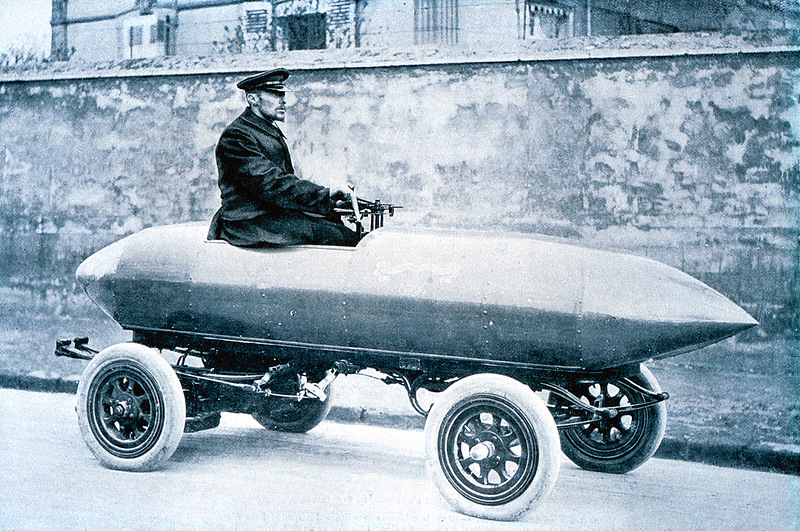
La Jamais Contente is a French electric car that set a speed record on April 29 or May 1, 1899 in Asher near Paris. Genatzi reached 105.882 km / h (65.792 mph).
Aircrafts
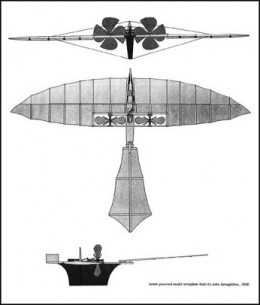
Aerial Steam Carriage password project for the English engineer William Samuel Henson (1812-1888). The aircraft, according to the author, was moving due to the propellers and flapping of the wings , but had too much steam drive. Only one model built was able to fly 20 meters.
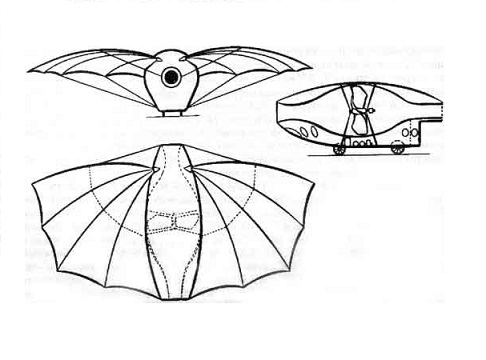
Bat wings in the design of the late 19th century. The German inventor Gustav Koch in 1893 proposed the construction of a tailless aircraft with a steam engine, outwardly vaguely reminiscent of the Aeolus, but even more unusual in design. Koch intended to install a propeller inside the round fuselage, that is, to create something like a hybrid of a vacuum cleaner and a bat.
Underwater technology of the 19th century.
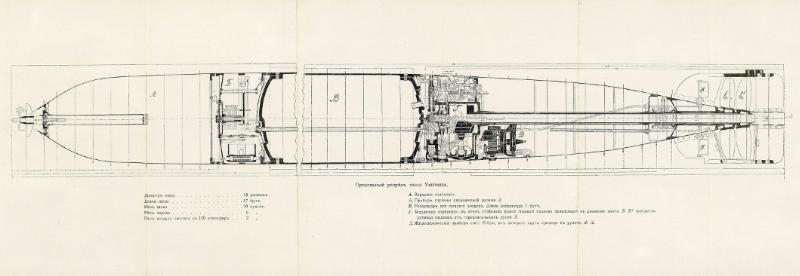
In 1865, the project of weapons (or as they called it "self-propelled dashboard") was proposed by the Russian inventor I.F. Alexandrovsky. The torpedo was equipped with a compressed air engine.
"Le Neptune" (1884) appeared at an exhibition in Nice; built by engineer Toselli. Surfaced - by pumping out ballast water , and more vigorously if you dump 2 external lead loads. This P. apparatus is a perfectly implemented device for people to stay at atmospheric pressure at a very significant depth.
Le Gymnote (1889)built by the civil engineer of the French fleet G. Zede based on the ideas of Dupuis de Loma; built and launched in Toulon. Its construction did not mean military objectives, and this P. boat does not carry any weapons. "Hymnos" is an elongated spindle 17 ¼ m long and 1.8 m in diameter at the midship frame, the size is just sufficient so that a person standing at the bottom of it has his head in a lantern or turret with strong glass windows. Displacement of 30 tons. All actions and mechanisms of the boat are driven by electricity, according to the Krebs system; its lightweight 16-pole electric motor with 204 batteries can tell a propeller of 1 ½ diameter a speed that is almost proportional to the potential difference between the battery bourns, which is achieved by a different grouping of batteries, totaling 67300 ampere-hours.The boat is divided along P.'s length by impermeable partitions into 3 parts. The bow reaches almost the middle of the P. boat, accommodates most of the batteries, a ram water compartment, behind it - a tank compressed to 75 atm. air; the valve comes out from the air pump, which ventilates and pumps air when the P. boat floats to the surface of the water, and almost in the middle - the visual device, periscope; 2) the middle part - from the middle of the P. boat to ¾ stern, contains the main and auxiliary vehicles, the commander’s turret through which the crew enters the P. boat; there is a screw seat, a gyroscope, a compass and a steering wheel, and two water tanks on the back on both sides; Behrens pumps for pumping ballast water;steering servo motor, manometer and electric motor with its devices; 3) aft compartment - holds a water tank for counterweight nasal; here the propeller runs along the axis. Outside: horizontal and vertical rudders, and back and propeller.
First kind of plastic
The first plastic was obtained by the English metallurgist and inventor Alexander Parks in 1855. Parks called it parkesin (later another name became popular - celluloid) . Parkesin was first presented at the Great International Exhibition in London in 1862. Parkesin was often called artificial ivory.
The invention of hydrogen, methods of storage and use of this gas
The evolution of combustible gas during the interaction of acids and metals was observed in the 16th and 17th centuries at the dawn of the emergence of chemistry as a science. The famous English physicist and chemist G. Cavendish in 1766 investigated this gas and called it “combustible air”. When burning, “combustible air” gave water, but Cavendish’s adherence to the theory of phlogiston prevented him from drawing the right conclusions. The French chemist A. Lavoisier, together with the engineer J. Menier, using special gas meters, synthesized water in 1783 and then analyzed it by decomposing water vapor with hot iron. Thus, he established that "combustible air" is part of the water and can be obtained from it.
The principle of operation of fuel cells was discovered in 1839 by the English scientist W. Grove, who discovered that the electrolysis process is reversible, that is, hydrogen and oxygen can be combined into water molecules without burning, but with the release of heat and electricity. The scientist called his device, where he managed to carry out this reaction, “a gas battery”, and this was the first fuel cell.
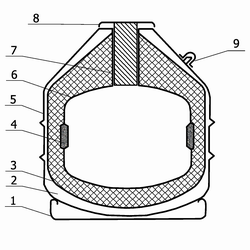
Diagram of the Dewar vessel
1 - stand; 2 - evacuated cavity; 3 - thermal insulation; 4 - adsorbent; 5 - outer vessel; 6 - inner vessel; 7 - neck; 8 - cover; 9 - tube for evacuation
The first container for storing liquefied gases was developed in 1881 by the German physicist A.F. Weinhold. It was a glass box with double walls with air pumped out from the inter-wall space and was used by physicists K. Olshansky and S. Vrublevsky to store liquid oxygen. Scottish physicist chemist Sir James Dewar in 1892 improved Weinhold’s glass box, turning it into a double-walled bottle with a narrow neck to reduce the evaporation of liquid. The interwall space is silvered and air is pumped out of it. Dewar first demonstrated his vessel to the audience at a public lecture on January 20, 1893. Dewar hung this entire fragile structure on springs in a metal casing.Thanks to his development, Dewar was the first to obtain and retain liquid (1898) and even tried to obtain solid hydrogen (1899). The original Dewar vessel was a glass flask with double walls, from the space between which air was pumped out to create a vacuum. To reduce the radiation loss, both inner surfaces of the flask were coated with a reflective layer. Dewar used silver as a reflective coating. Modern Dewar vessels are structurally different. The inner and outer vessels are made of aluminum or stainless steel. Heat loss of the material in this case is not very important, and strength and weight play a big role.
The ideal drive for the mahoul
A study of the flight of birds showed that with an increase in the size of the bird, the number of flapping wings decreases. The approximate number of strokes for a manned ornithopter will be approximately 50 strokes per minute. Due to the need to transform rotational motion into translational and reduce high revolutions, modern ICEs are not the best suited for solving this problem, like an electric motor. Even if you “rid” the internal combustion engine of the crankshaft, make it slow and transfer the translational motion of the pistons directly to the wing levers, then the problem of inertial forces arises - when trying to transfer the work of expanding gas during an explosion in a short period of time for the movement of relatively large massive wings.
At the same time, for example, a steam engine that allows you to adjust the speed and smoothness of the movement of the pistons would be much better for transferring energy to the flapping wings. The very task of building an ornithopter in this case comes down to designing the engine and its components, a boiler with a furnace, a condenser, etc., in accordance with the aerodynamics and kinematics of the aircraft. The very property of a steam engine to automatically increase torque with a decrease in speed makes this type of drive ideal in conditions of constantly changing resistance of the external environment when the wing flaps.
Steam turbine + electric generator
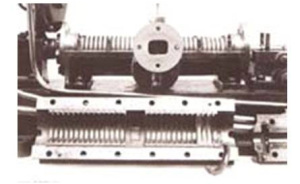
In 1884, the English inventor Parsons patented a multi-stage jet turbine specially designed by him to drive an electric generator. At a lower rotational speed, the steam energy was used to the maximum due to the fact that the steam, passing through 15 steps, expanded gradually.

In 1894, the first Turbinia steamer launched from a steam turbine was launched. Soon, steam turbines began to be installed on high-speed vessels. French scientist Rato has developed a comprehensive theory of turbomachines based on experience. Over time, the Parsons turbine gave way to compact reactive turbines. Although today, steam turbines have largely retained the features of a Parsons turbine.
Tesla
Impressed by Tesla's experiments, Jules Verne creates his captain Nemo, and the newspapers crown the scientist with the laurels of the “lord of lightning.”
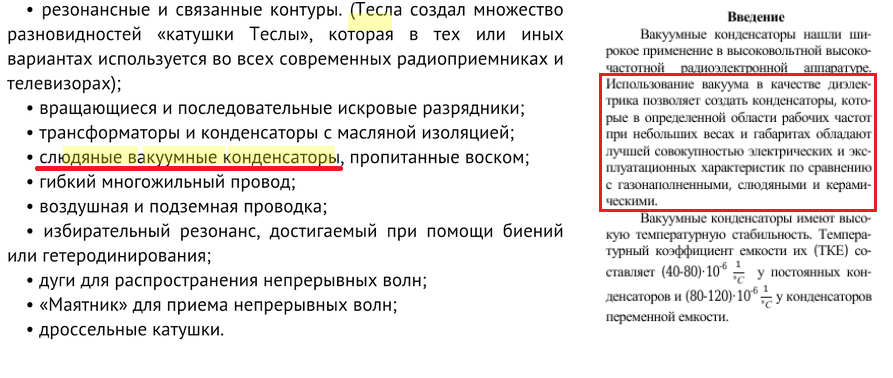
Tesla Vacuum Condensers are listed in Nikola Tesla's book. The messenger of another world. Man X (Mark Livintal).
Many of the scientist’s experiments cannot be repeated to this day, and his article “World System” of 1900 surprisingly accurately describes the information society of the beginning of the 21st century.
Tesla's AC machines proved to be more economical than Edison's DC devices. With their use, a number of industrial electrical installations were launched in the United States, including the largest Niagara hydroelectric power station in those years.
In “Robur the Conqueror” and “Lord of the World”, the Niagara GES is mentioned several times, and many events unfold in the same way around it.In 1892, Tesla visited London. Here, in front of the eyes of the "most respectable public", he demonstrates the ignition of a lamp by means of wireless transmission of electricity. The scientist connects himself to a high-frequency alternating current circuit, causing his body to glow in the dark with a strange bluish flame.
Returning to New York, Nicola told reporters: “I do not work anymore for the present, I work for the future. The future belongs to me! ”
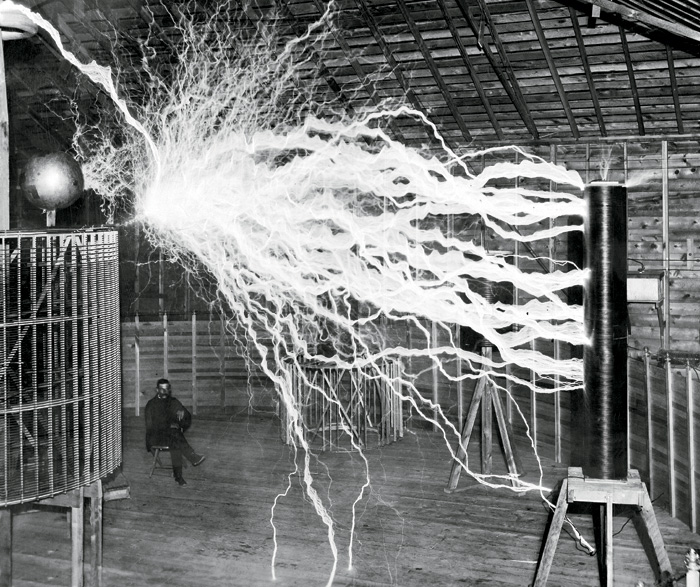
This photo was taken at the Tesla Laboratory in Colorado Springs. Here, in 1899, the inventor investigated thunderstorms and the electric potential of the Earth, dreaming of creating a system of wireless energy transfer to anywhere in the world. For six months, Tesla conducted a series of experiments to study the properties of atmospheric electricity.
There is a description on Habrésmartphones in the view of Tesla , combat drones , but Tesla's inventions are numerous, and therefore the best is listed in these films.
All these inventions were breakthrough during the time of Jules Verne, and they are displayed not only in the story of flying cars. Further, on the basis of these inventions, and information about the device and observations of the three-elemental apparatus, I will express my versions of its device.
Winged monster
“And if it was light, people from villages and farms could notice how some gigantic bird of prey flashed across the sky , some kind of winged monster that, rising above Great Air, flew east!” (1. What happens in district)
"But what about the flames that appeared from behind the rocks?
“Oh flame, Mr. Strok, this is another matter! ...
I saw him, saw with my own eyes, and even at a great distance the clouds were painted with his glow. In addition, a noise was heard from the top, similar to the whistle of steam released from a boiler . ”(2. In Morganton)
“ The main engine consisted of two Parsons turbineslocated longitudinally on both sides of the keel. Propelled by these turbines at tremendous speed, the screws crashed into the water, causing the apparatus to move in the water, and I even asked myself if they would give it the same translational motion in the atmosphere. "(15." Eagle's Nest ")
" The device rocked several times, then the lower turbines spun quickly, and I heard the measured flapping of mighty wings. " (17." In the name of the law! ")
" Once on the deck, I saw something that wasn’t I could see during the night flight from Niagara Falls to Great Airy - I saw how two huge wings act, flapping at the left and right sides, while the turbines rotated furiously under the platform of the device. ” (17.“ In the name of the law! ”)
These sections from a book on mighty wings often misled the reader, who still believed that the machine was moving due to “flapping wings,” that is, the Makholet — ornichopter. This statement is fundamentally wrong, and it will become clear if you carefully read these segments and compare with reality.
So at the beginning of the book and at the end we are given to understand that the car moves only after the turbines start! There is no independent flapping of wings for takeoff in principle! Further, it is made clear that the drive in water is driven by turbines that rotate the propellers, and it is suggested that in the atmosphere these propellers help the movement, but what is especially important - there is more than one hint of the use of steam (Parsons turbine is steam in the “real world”).
What follows from this? But just thatwings here play the role of a stabilizer in space. Screws carry out the main work of creating traction, and steam comes out of the car sometimes, and can also serve as an “accelerator” . More details why it will be lower.
The questions are what kind of monster this is, as you see, there are more than answers, but the MAIN QUESTION arises! WHAT IS ENERGY FOR CREATING A STEAM? WHERE ARE THERE SO MUCH WATER?
GROZNY
«Робур стоял в той же позе. Положив одну руку на руль, другую — на регулятор, он направлял сильно взмахившую крыльями машину от тучи к туче, в самую гущу грозы, туда, где электрические разряды происходили особенно часто.» (17. «Именем закона!»)
«Отсюда следовало, что эта машина приводилась в движение электричеством и аккумуляторы ее, неизвестного типа, заключали в себе, так сказать, неиссякаемые запасы энергии.» (4. Гонки автомобильного клуба)
«Все предполагали, что она, вероятно, приводится в движение электрическим мотором, но никто не мог догадаться, от какого источника питается этот двигатель.» (4. Гонки автомобильного клуба)
«It must have acted with the help of electric energy of an unusually high voltage, the source of which, apparently, was here on the ship. But in this case, another question arose: where did the electricity come from - from galvanic batteries, from batteries? And how do they charge - these batteries, these batteries? Where do they get their energy from? Where is the power station that produces it? Are they not extracting electricity here from the surrounding air, or from water, using methods unknown to anyone now? "
“As for the energy that supported and moved the apparatus in the air, it was delivered not by water vapor or any other vapor, liquid, not compressed air or some other elastic gas. It was also not a mixture of any explosives. No, the Albatross was set in motion by the force that is used for many other purposes - electricity. However, how and where did the inventor draw electricity in order to charge the batteries? It is quite possible (after all, his secret remained unsolved) that he extracted energy from the surrounding air, always more or less charged with electricity, just as the famous captain Nemo, plunging his Nautilus deep into the ocean, extracted electricity from the environment. " (16. Robur the Conqueror)
" She had the form of a spindle;its greenish color merged with the color of sea water. "(5. Off the coast of New England)
Probably it does not immediately become obvious, but in the book, in the form of doubt, a direct explanation of the power source of Grozny is expressed. It is possible to extract energy to the greatest extent possible in the air only during a Thunderstorm, directly coming into contact with charged thunderclouds.
It’s clear about the source, but guessing about the battery. At that time, they could not know about the properties of water to decompose under the influence of strong voltage (electrolysis), and they also knew about the possibility of creating fuel cells on the opposite principle. The first experiments were conducted to reduce the resistance of a conductor by cooling to low temperatures ...
Combining these guesses, it can be assumed that the energy of electric lightning discharges was converted, and partially accumulated using vacuum capacitors, in order to then conduct electrolysis of water with the subsequent production of hydrogen for liquefaction. The conductors before and after the capacitor in vacuum could be cooled with the same hydrogen, which significantly reduced the resistance. There is only one need for capacitors - to instantly accept the entire charge of lightning. Perhaps the electrical engineering at Grozny could operate at ultra-high voltage due to the same cooling of conductors with liquid hydrogen (or other gases included in the cascade method of producing liquid gases). As you know, the most high-performance generators have just such cooling
.
Another advantage of the hydrogen theory would be the ability to store fuel on board the Robur’s apparatus that can be converted into steam during combustion (for Parsons turbines) and have an oxygen supply for the “submarine” mode.
The theme of cryonics in the books of Jules Verne was revealed in the novel "Five Hundred Million Begumas" in 1879, where the plot used shells with liquid carbon dioxide. This book is mentioned in the first Robur the Conqueror book about Robur.To store a large supply in the case of a superconductor-battery is also possible in theory, but until the time of writing the book this property of the conductor was not discovered, and Jules Verne could not know about it. However, it is possible, while communicating with scientists, he could still suggest superconductivity.
Now a little about the location of these drives in the process of generating energy ...
The Grozny case, according to String, was made of aluminum, but the description of the device in the water indicates that it has “turned green”, and this is already a reaction of another metal. Following the logic of obtaining energy from air, it would be logical to reduce the resistance to the passing current through the body, and then most likely they used “silvering of aluminum” . As for the energy storage, most likely we are talking about capacitors, which were located in the casing of the "Grozny" in a vacuum . Such a design made it possible to partially transform the entire body of the apparatus into a “Dewar vessel”, which facilitated the storage of the obtained hydrogen in a liquid or solid phase inside the center of the machine. Silvering of aluminum here was also internal, since in the original “Dewar vessel” this process also performs the protective function of a barrier to hydrogen (silver is not saturated with hydrogen).
The episode with the crash of the ship can then be explained by the breakdown of the machine from overcharging, which caused first the destruction of the capacitors in the vacuum of the sheathing (a slight tremor went through Grozny throughout the hull. Note from the book), and then the loss of thermal stability of liquid hydrogen because of this, which caused explosive its output in the form of gas through the Parsons turbine and other elements. The destruction was swift, and there was no smooth ignition of hydrogen precisely because this gas had extremely high volatility, and left faster than it could catch fire in a rapid stream of air, and there was no burning right after the explosion. The key point in the release of hydrogen through the ship's hull was its effect on metals. It has long been known that cooling metal to low temperatures contributes to cold brittleness - the phenomenon of cracking of metals. It was because of this rapid cooling in the center of Grozny that the case broke, since the tank was supposed to be located in the center according to the layout logic (the machine body is a spindle, and therefore most of the place for the tank is in the center). The destruction of the wing-flapping mechanisms also happened due to the passage of cooling gas into the steam wing drive mechanism. On the whole, in Grozny, in addition to metal mechanisms, there was also a certain amount of water, and therefore the rapid freezing of just this substance could trigger a destruction reaction (ice during freezing increases several times, and in addition it becomes very The destruction of the wing-flapping mechanisms also happened due to the passage of cooling gas into the steam wing drive mechanism. On the whole, in Grozny, in addition to metal mechanisms, there was also a certain amount of water, and therefore the rapid freezing of just this substance could trigger a destruction reaction (ice during freezing increases several times, and in addition it becomes very The destruction of the wing-flapping mechanisms also happened due to the passage of cooling gas into the steam wing drive mechanism. On the whole, in Grozny, in addition to metal mechanisms, there was also a certain amount of water, and therefore the rapid freezing of just this substance could trigger a destruction reaction (ice during freezing increases several times, and in addition it becomes verysolid with a strong minus ). Again, it is worth considering that the folding mechanism of the wings was also located in the center, which means that this was the weakest point in the structure due to the large number of stress points.
The casing of Grozny was enormous in strength, but, like modern submarines, it does not save from an internal explosion that causes a similar rupture of the hull.
This is only one version of the breakdown, but there will be a second. This version is “complicated”, since I assume that the principle of dual use was most likely used in this design. Not to use the vacuum between the walls for capacitors means to increase the size of an already complex machine, but to use this risk (which Robur was always more willing to do, since, as we recall, he didn’t provide ANY SHOW on Albatross!)
A little about the name "Terrible"
As you know, Jules Verne has always tried to choose the names for his devices based on their environment and function. The Nautilus (submarine) is named after the Nautilus marine animal, “Albatross” was a reference to the Albatross bird (which flies long distances for days), but “Terrible” is what? According to my version, this is, as you already learned, a characteristic of the principle of energy production. Therefore, the name of the car is an adjective, not a noun, following the example of the names “gasoline”, “diesel”, “steam”, etc. (and what name would you come up with if there were no options among the animal world and even modern ones analog time?)
When using my version, there are no contradictions, since this word also reflects the essence of the apparatus, as well as the name of the others. Of course, a version may arise that this is a kind of threat in the name, but if you compare the device with "Albatross" it does not look so "formidable". The previous Robur apparatus, although it did not have the ability to move across water and land, was seriously armed, and even participated in the attack on the king of Dahomey. "Terrible" did not even begin to fight off the attackers in the bay of Black Rock! Or maybe he had nothing to fight back except for those pistols that were in the hands of his accomplices? In any case, the “Terrible” in “The Lord of the World” did nothing wrongful and threatening in comparison with the “Albatross”.
Another argument in favor of the thunderstorm theory.
“It remains to find out what material the engineer Robur used for his airship: by the way, the name“ ship ”is quite suitable for“ Albatross ”. What kind of material was it - so strong that Phil Evans' sharp knife could not even scratch it, and Uncle Prudent could not unravel its nature? Just paper!
For many years, the manufacture of this kind of paper has taken wide dimensions. The glued paper, the sheets of which are impregnated with dextrin and starch, and then passed through a hydraulic press, forms a material as hard as steel. Blocks, rails, wheels for cars made of it are stronger than metal products, but much easier. It is this strength, combined with lightness, that Robur decided to use when creating his aircraft. The hull, deck, deckhouses, cabins - everything was made of straw paper, which under the press turned almost into metal; this paper has acquired another property - non-flammability - which is especially important for an air ship moving at high altitude. The various components of the lifting apparatus and the traction apparatus — the axles and propeller blades — were made of gelled fiber, both durable and flexible. This material, capable of taking any form that does not dissolve in most gases and liquids, in particular acids and alcohols, not to mention its insulating qualities, was simply irreplaceable in the engine room of Albatross. ”(Excerpt from the book Robur the Conqueror ")
The Albatross was made of lightly processed paper of unprecedented strength, and the Terrible consisted of an aluminum case, which is still heavier than paper, so why was the metal chosen? The only plus of metal in this case is the ability to conduct current! What paper composite was deprived of.
Dimensions of the Robur machine
The approximate dimensions of "Grozny" is approximately easy to become. It is enough to know the main figure - no more than 10 meters and the shape of the machine. Based on this parameter, you can further determine the height and width based on the fact that the roads in the USA at the described time were wider than 2 - 4 meters. The spindle shape in this case will help us to establish the ratio of width to height, since the rounded body means that the height cannot differ greatly in width, and the height of the wheels (at least half the height of the wheel) should be added to this.
It turned out approximate, but very important data for further "investigation".
The issue of wings is the hardest. There is already an area of conjecture wider, since it will have to proceed from the ratios of the body length and wings of birds (which are often mentioned in the story), but it is obvious that this may not be true. The drive in the air, as I already wrote, was not provided with wings at all, which means that the size of the wings could not depend on the necessary proportion for lifting the apparatus. In the description of the wings there is no exact data, and the approximate data are the same, but taking into account the frequently encountered description of natural phenomena embodied in mechanics, we can conclude that the bat wing is taken as the basis (the mention of the bat is in Robur the Conqueror). An additional argument in this direction - the description of the car never mentioned the presence of at least some tail behind the Grozny, and the wings are described as folding (in birds, the wing has a simpler structure,
Therefore, applying the proportions of the aircraft in the approximate data obtained can narrow the estimated range of the volume of the device. The length of the wings can be taken as "no less" than the average 4-seater aircraft. Of course, the weight factor remains, but here we must take into account the carrying capacity and energy intensity of Grozny. With a sufficiently high supply of stored energy on board, the weight factor may play a smaller role.
The most popular aircraft of the twentieth century were light 2-4-seater sports 2 and similar on average 8 meters long.
But still, why a bat wing, not a bird? We read an excerpt ...
"Board devices like those that are found on Dutch galleots were driven to the sides of the vessel: their purpose was not clear to me." (13. On board the Grozny) Later on, when
painting the Terrible, illustrators of books always painted these “devices” in one manner.
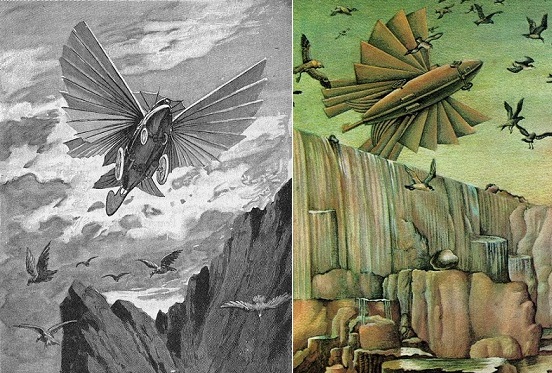
With the exception of errors like extra wings, different wheels and a tail (about which there is not a word in the book), everything is true.
Now take a look and compare the hand of a man, a bird and a bat.
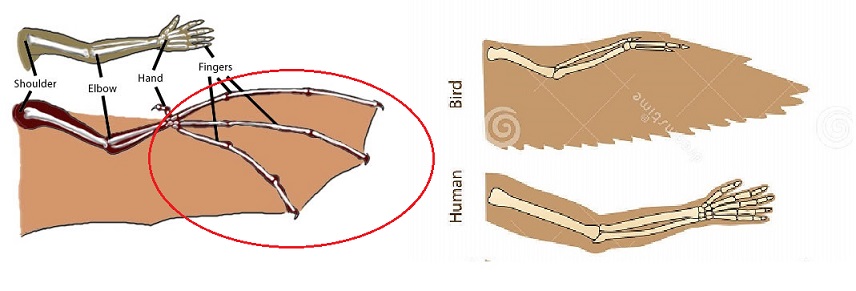
As we see "board devices" these are most likely the fingers of a bat, by analogy with the fingers of a person. Birds, in principle, do not possess any “boards” and are structurally much simpler.
These were all assumptions, but what about the facts?
Here are a number of "iron" facts in favor of the "flying".
Bats are the most maneuverable flyers known today. They have aerodynamics and maneuverability superior to those of birds and insects. The wing has a hand with very elongated fingers with a large number of joints and a thin membrane between them. The skin of the membranes is very elastic and is able to stretch without breaking four times the original size.
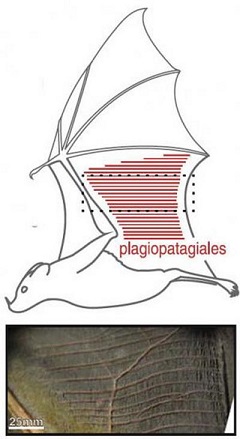
In addition to the muscles near the bones, the threadlike muscles located in the wing are also responsible for the increased elasticity and controllability of the wing (it looks like strips throughout the wing).
Do you still believe that the "board devices" were without flexible "skin" at the junction of the "boards"? But what about the aerodynamics of this design? After all, the gaps between the boards need to be filled with something, otherwise it will be just the chaotic movement of the sticks in space, which with its vortices will nullify the effect of the wing flap. The birds are simple - the wing space is not completely filled with "boardwalk", but with flexible "meat with feathers" and there is only one "stick-bone on which everything holds."
We conclude that only bat wings could be “boardwalks”, since even insect wings do not fall under this definition.
Physics of bat flightThe description of "Terrible" just talks about the "amazing controllability" of this device in the air.
The principle of flight of bats differs significantly from the principle of flight of birds. The main feature is the flexibility and suppleness of the wing of the bats. The strong bend of the wing during its downward movement gives a much greater lifting force and reduces energy costs when comparing bats with birds.
During each movement of the wing downward, a swirl of air is formed at the leading edge, which provides up to 40% of the lifting force of the wing. Airflow begins at the leading edge of the wing, and then bypasses it and returns again while the wing is moving up. Thus, the air pressure above the wing is reduced by this flow, allowing the bats to use the wing muscles more efficiently. The control of turbulence is possibly achieved due to the extreme flexibility of the wing. Bending it allows you to keep a twist near the surface of the wing.
Performing flies, bats hold wings much stronger than other flying creatures. This reduces air resistance, that is, improves their aerodynamics. The flexibility of the wing significantly increases the number of ways to use it in flight and allows, in particular, to make a 180 ° turn at a distance of less than half the wing span.
After all of the above, it is easy to find the answer to the question - "why is there a turbine with screws down there?".
The purpose of the screws in this case is to create “vortices” - forward thrust, and control their intensity. Without "twists" this semblance of a "bat" is simply not able to fly!
And do you still believe that the “Terrible” was an ornithopter because it fluttered its wings?
Of course, in our time we have learned to make bats, without the method of creating vortices described by me.
For example, the drone Bat Bot .
The key point here is the size of this unit and its effectiveness in comparison with the "flying" one. Simulating a flight does not mean getting all the benefits of the “original”. Even Robur in his speech spoke of the need not to completely copy nature, but only to imitate it in really beneficial moments. Unfortunately, the scaling of many natural processes in mechanics is often a failure, and you have to come up with some “crutches” - substitutes for processes on an enlarged copy of “imitators of nature”.
I suppose the same process was used at Grozny. In the same way, Robur described the appearance of a screw instead of wings in technology in Robur the Conqueror.
Now, having figured out the source of energy and the dimensions of the apparatus, it’s worth moving on to the secondary elements and the story’s development story.
On the ground…
The start of his journey on earth with the "Terrible" many critics raises a number of questions. One of the first was “how could it be invisible to the eye at a speed of 250 km / h and maybe even more if it is already proven in our time that this is not so?”, And the second question is “how could such a machine leave a light mark on the road, according to the wrong explanation that the mass of the car becomes lighter depending on the speed? ”
The first question lies in the field of understanding the state of roads and the world of modern man, but it is not surprising if you know what roads were in the USA in 1900 (in the rest of the world it was the same in general, but it is about the roads of the USA). But these roads were mostly unpaved, and rarely when paved in separate sections. Crushed stone, sand and in our time is used to repair roads and you can see that the effect of "invisibility" is also very noticeable.
As you can see in the video, the speed is clearly not 250 km / h, and cars already with a good tail are coming out of dust.
Separately, it is worth mentioning that after parsing the power source, I think it is clear that a vapor cloud could well be added to the dust curtain in motion?
“Suddenly, when the clock on the town square in Prairie do Chin struck half past nine, two miles from this town there was a terrible noise: something was rolling in a thick cloud of dust, with a roar like the howling of a sea siren. "(4. Racing automobile club)
" She disappeared in an instant, raising a long strip of white dust, similar to a strip of steam that stretches behind a steam train of a courier train . "(4. Racing automobile club
From these passages it is clear that this was so. Separately, it is worth mentioning that the appearance of the car occurred “suddenly” outside the city, and as we know, the ability to fly was the first for this car, and therefore it is logical to assume that the car landed from the air.
The second question is already from the field of aerodynamics, namely the section on downforce. Even today, in order to move normally at speeds above 100 km, you need to consider the need to create additional downforce due to the shape of the car or anti-wing. This additional pressure on the tires compensates for the forces tending to lift the car off the surface and contribute to better traction at high speed (which is extremely important for maneuvering). Another fundamental point is the very possibility of movement due to the adhesion of the wheels to the road, which is ensured by this pressing with the necessary effort. At the beginning of the century, they already tried to solve this problem by aircraft - making an air propeller a source of traction and maneuver at speed, and use tires only for maneuvering at low speeds. Now let's remember what “Grozny” is all about - a car whose movement in space is provided by turbines, wings, that is, manipulations with the surrounding air - water environment, and it follows that it does not need downforce for the wheels! Driving on a hard surface of those times can hardly be called comfortable due to uneven roads and uneven adhesion of wheels to the ground, and therefore this only adds to the assertion that the car used the wheels mainly to maintain the car at a certain height above the road, but as the main traction they are not were used. Perhaps the blades on wheels could be used to maneuver by creating lateral traction, but in principle the Robur machine always chose straight sections of roads (which is not surprising since it is difficult to make any maneuver at 250 km / h).
The book clearly states that the driver was not visible when the car was moving, and even the race participants could not see it when he overtook them. Let me remind you that the speed is 250 km / h! And how could Robur drive a car at such a speed in a cloud of dust and steam, and a strong incoming air stream? The control cabin was aft! The answer is given later in the book - this is a periscope (mounted on the nose of the device)!
In water, and under water ...
Water ... This is probably the exact environment for which Grozny was particularly suitable. With a spindle-shaped casing and two steam turbines with screws, this machine could move in water, and under water like a torpedo.
“I only noticed that this high-speed boat left a long, flat stream behind the stern .” (13. On board the Grozny)
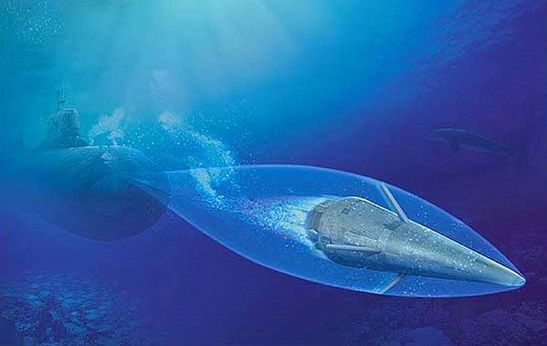
Doesn't it look like a trail from a torpedo?
Modern analogues use the same steam.
Considering that the acceleration of torpedoes still occurs due to vaporization, such an accurate description of the process of movement on water leaves no doubt.
Under water, the movement was probably ensured by the traction of the wheels with the blades. The book also says about the possibility of using wheels for maneuvering under water, and what is remarkable - for driving under water! This means that the wheels in this case are swivel, and simply turn into propellers when turning relative to the body.
Oxygen for breathing? Well, we remember that water, when decomposed, gives oxygen? Of course, comparing with 20 thousand leagues under water, it’s stupid to assume that such a small ship-car-plane doesn’t have a supply of compressed (or liquid?) Oxygen.
Паровой привод-ускоритель тут то же не просто так. Кроме избавления от пара под высоким давлением возможно и заполнение полости водой для погружения? Управление плавучестью за счет заполнения водой в случае подводной лодки обязательно, а если учитывать что эту воду можно еще и нагреть до состояния пара…
Возможно что «подняв длинную полосу белой пыли, похожую на ленту пара, которая тянется за паровозом курьерского поезда.» это всего-навсего обычная… соль? Которая выпала в осадок при выходе перегретого пара когда «Грозный» ускорялся на земле?
Now I understand why the mechanism of immersion under water at Robur broke? All the same, boil seawater, and then fresh in the lake, and hopes that this will not damage the TENI (or other heat exchangers) is very short-sighted. To understand why all the same, these tests were carried out from the point of view of testing the maximum regimes of the “Terrible”, which, in essence, Robur was engaged in, so breakdowns in this case were commonplace. An accident with a ram of a ship in the lake could also violate the stability of a number of mechanisms, and that is why the hatch in the engine room was opened (perhaps they got rid of small hydrogen leaks).
In the air…
Flying in the air of "Grozny" is not interesting by the very fact of flight and partial use of the bat principle discussed above. Rather, more interesting is the scheme of the device, which is now called the “wing aircraft”. The disadvantage of this scheme is precisely the difficulty of maintaining a stable flight, due to the lack of "stabilizers" as on conventional aircraft.

The American Northrop B-2 Spirit is on the left, and its “grandfather” is the German “flying wing” project on the right.
A winged plane is considered a promising scheme that was implemented on Stells fighters, but in this type of aircraft electronics are responsible for stabilization in flight (by manipulating thrust, flaps, etc.), and in the case of Grozny stabilization was achieved due to the active movement of all wings (the advantage of the mahogany is that it can itself regulate the process of influencing the environment, and not passively respond to the incoming air flow)!
About the wing drive
The question of using a steam wing drive can raise doubts ... After all, besides heating the water to a state of steam, does it still need to be cooled somehow? Do not let all the water, but only a part, because using hydrogen at the outlet we always get water, but this liquid is clearly not enough to drive such a powerful mechanism (especially if it is simply thrown away)?
That is why to help in solving this problem, you can again take an example ... bats!
The fact is that living bats also have problems with thermoregulation, and use wings to cool the blood in which they are cooled by an incoming air stream. The same natural radiator can be used by Grozny, flapping its wings to cool superheated steam. Subsequently, the steam could pass through the turbines and already completely return to the “accelerator” tank.
In the same tank or tanks, besides steam, other gases or liquids could be stored if there was no need for underwater movement.
The presence of an “evaporator” converting liquid hydrogen to a gaseous state could also help to cool the vapor, but still this would clearly not be enough under heavy load.
The flight and landing modes were the same two!
«Внезапно, когда часы на городской площади в Прейри-ду-Шин пробили половину десятого, за две мили от этого городка раздался ужасный шум: что-то катилось в густом облаке пыли, с ревом, похожим на вой морской сирены. Она исчезла в одно мгновение, подняв длинную полосу белой пыли, похожую на ленту пара, которая тянется за паровозом курьерского поезда.» (4. Гонки автомобильного клуба)
«Ну а пламя, показавшейся из-за скал?
— О пламя, мистер Строк, это другое дело!…
Я видел его, видел собственными глазами, и даже на большом расстоянии облака были окрашены его заревом. Кроме того, с вершины доносился шум, похожий на свист выпускаемого из котла пара.» (2. В Моргантоне)
«Котловина имела форму почти правильного овала, тянущегося с Юга на Север. Она была окружена стеной скал, но судить о том, какова была высота этих скал и строение хребта, я не мог: над нами стоял густой туман, еще не растаявший от лучей солнца.» (15. «Орлиное гнездо»)
«Местами широкие полосы испарений доходили до песчаного грунта» (15. «Орлиное гнездо»)
«Время от времени туманная пелена наверху разрывалась, и я видел силуэты громадных птиц, чьи хриплые крики нарушали глубокую тишину. Как знать, быть может, появление этого гигантского крылатого чудовища напугало пернатых, — ведь они не могли бы соперничать с ним не в силе, ни в высоте полета.» (15. «Орлиное гнездо»)
«В эту минуту сильный порыв ветра пронесся с востока, и небо мгновенно очистилось от тумана.Bright rays of the sun, which had not yet reached their zenith, flooded the site. ”(15.“ Eagle's Nest ”)
Fog in the nest of the mountain? And it’s not artificial, like landing outside the city with the release of steam, and the first take-off that he saw ....? To take off vertically, by analogy with modern vertical take-off aircraft, steam was released under high pressure creating jet thrust (the same process for landing at a “point”). In this case, the wings additionally receive denser “air” under the wing, which also facilitates their work.
To summarize in a few Mind map.
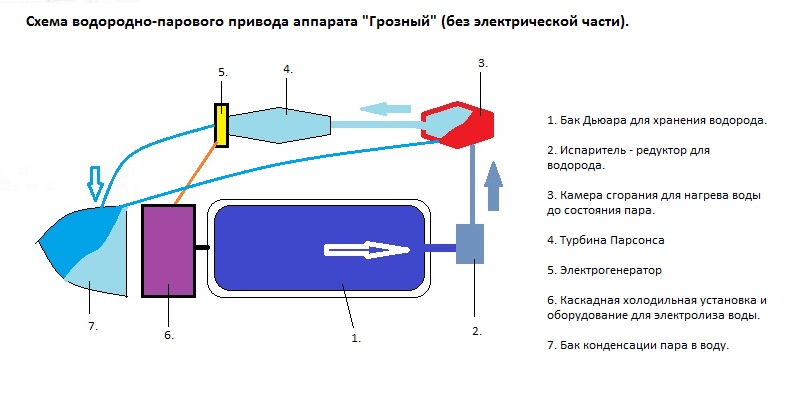

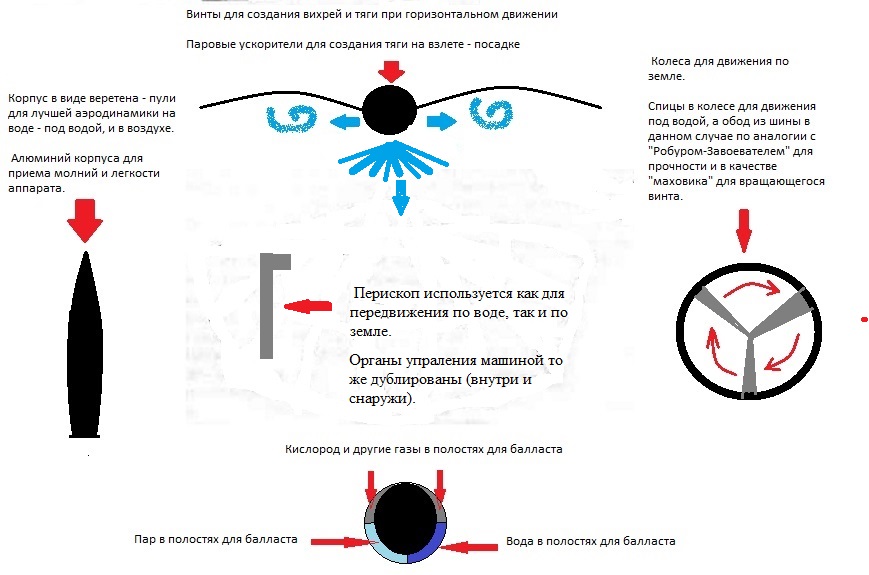
Robur "created" such a unique machine that it is probably difficult to give some general definition.
It was not for nothing that Jules Verne was a fan of the society of “apparatuses heavier than air”, as he was able to combine in a bizarre way a plane — a plane and a steam rocket!
The plot of the book is the same based on an understanding of the elements of the machine looks different.
The conclusion about the book, as well as the impression of those read. The device features already form a different picture of what is happening. Robur is no longer "crazy", but simply an engineer testing his technique, and the plot now looks like this.
The first stage of the tests, Robur conducted directly in the mountains and smoke, i.e., steam is in this case on-site tests (by analogy with the tests of each new machine on a treadmill before release).
The second stage is checking the movement of all systems. At this stage, problems had already arisen, and the probability of finding a base in the mountains was added to them (therefore, Robur was so hurt by this journey of String to its base).
Third stagethis is a full-fledged, but forced long-distance test, but it’s also an obvious concrete movement to a constant source of lightning energy - Lake Marocaibo in Venezuela .
The fact is that catching lightning charges only occasionally, it was a test of the system at minimum loads, and naturally, for more power, Grozny needed a more constant source of charge.
The only problem was that the repair did not explicitly fix the hydrogen leak in the engine room, and therefore the book so often mentions the constant going there.
The reason for the final of “Terrible” is inherent in the design itself - the purpose of the device.
In this case, you can compare the “Albatross” and “Terrible”.
“Albatross” according to the book “Robur the Conqueror” is a machine without the possibility of obtaining an external source of energy, which is directly indicated there. The multicopter was intended only for traveling around the air, and most likely flew on hydrogen fuel cells (Mentioned batteries are a necessary “buffer” for smoothing the growth of current consumption, since fuel cells are not able to drastically change the output current parameters ).
In the same “Robur the Conqueror” there is an episode where “Albatross” almost fell due to lightning electricity, which sent a stupor to the battery and blocked the current access to the screws (Episode over the Caspian Sea). The moment with the water intake is the same funny, because open-type batteries need a lot of water ... and it is the distillate from the hydrogen reaction and they are added to them, and not the drinking one that everyone thought of (ordinary water is not suitable for batteries!).
But back to Grozny. The perfection of this apparatus lies not only in its three-spontaneity, but also in the ability to take a lightning charge, and then process it into a supply of liquid (or maybe solid?) Hydrogen. The principle of fuel cells was rejected here because of its instability to atmospheric electricity, and therefore there is a process of burning gas. As they sometimes say, “the best enemy of the good”, and with “Terrible” it turned out the same.
As is known from the Hindenburg tragedyand other airships electricity + hydrogen is a very dangerous concentration in an enclosed space. There was no such problem at Albatross due to constant ventilation and speed, while Grozny literally emerged from the water before the tragedy and soared into the air. Of course, the engine room hatch was closed (was it repaired?), But if there was still a slight leak, then the dangerous situation was supplemented by the most unfavorable factor! The process of charging from lightning and working at high loads!
So, the "Terrible" did not complete his mission ... but the book does not state that the crew was definitely dead, and Strok himself survived! So there is every chance what and how in "Robur the Conqueror" the main character survived.
Therefore, the continuation of the story could well have been. Moreover, the book contains a number of allusions to the further actions of Robur.
After reading my article, I advise you once again to read the books "Robur the Conqueror" - "Lord of the World", and take a different look at this work. Then the feeling of understatement and illogical plot will go away.
PS - In an attempt to unravel the technical features of the Robur machine, I came across a number of unexplained moments, for which there is no clear answer. I hope readers of Habr will be able to find an explanation for these technical puzzles.
Here they are:
"Turner went down to the engine room, and I noticed that it was lit by electric bulbs, the light of which, however, did not penetrate outside."
What was that light?
“From this side, their outlines were very bizarre: some rocks formed peaks, others - sharp spiers, the strange silhouette of one of the cliffs resembled a huge eagle, ready to fly into the heavenly expanse”
“One way or another,” said Harry Horn, “the collapse, as you can see , occurred here, and yet no gap was noticed in this part of the wall ”
“ Meanwhile, we continued to walk around the rocky wall, which looked so much like a regular rampart that it seemed to be the creation of human hands, and not the creation of nature ”The
mountain was processed by what? And why?
“The deck and sides of the ship were made of metal unknown to me.”
Unknown metal - is it metal? If in the past, “Albatross” was from a paper composite? Can plastic look and feel like metal? Judging by the further description, the impression may be that the deck is fully open, but is it really so?
“I broke red wax seals on an envelope made of very thick paper. These seals depicted something like a shield adorned with three stars. ”
What did this symbol mean?
This article was written for habr.com . When copying, please refer to the source. The author of the article D. Efimenko

